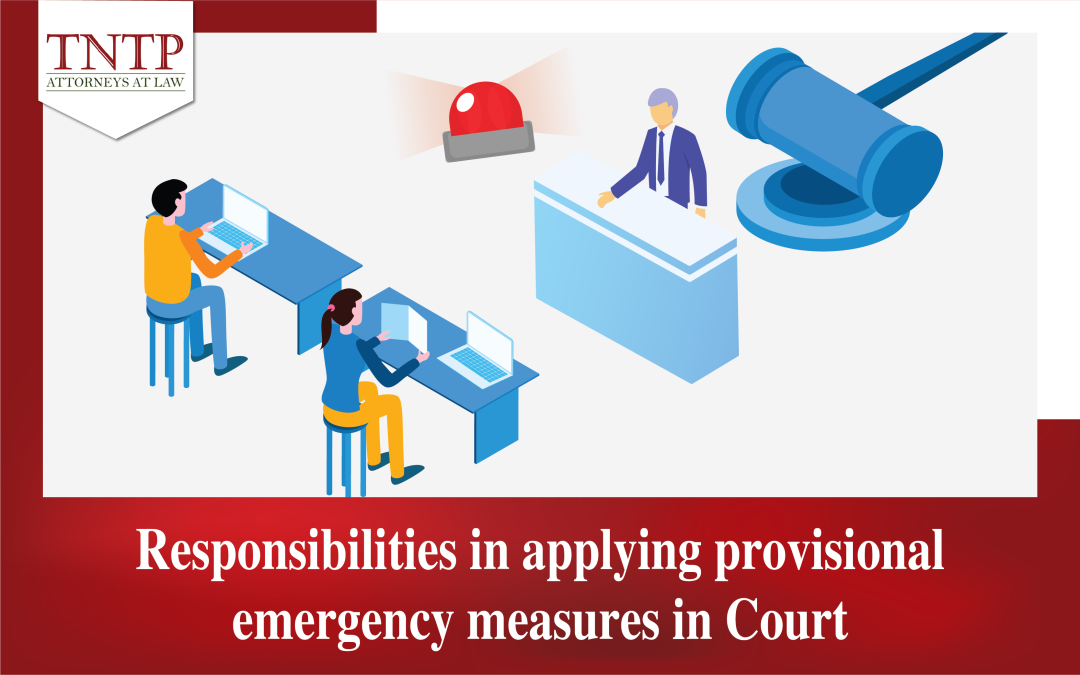Applying provisional emergency measures helps prevent potential damages. Therefore, such measures must be carried out carefully and promptly. The decision to apply provisional emergency measures imposes high demands on the responsibility of the Court and related entities. In this article, TNTP will analyse the applicant’s and the Court’s responsibilities when applying provisional emergency measures.
1. Responsibility of the applicant requesting provisional emergency measures
The applicant requesting the application of provisional emergency measures must bear responsibility for their request as stipulated in Clause 1, Article 113 of the 2015 Civil Procedure Code (“CPC”). This aims to ensure that applicants do not misuse this right to cause harm to others.
The requester must clearly and fully state the temporary emergency measures they want to apply in the request and provide grounds to prove their necessity and legality. If the request is incorrect or unfounded, resulting in damage to the person against whom the measure is applied or a third party, the requester must be responsible for compensation.
When requesting the Court to apply provisional emergency measures, the applicant must prove that failing to apply such measures could lead to irreparable or hard-to-remedy damages.
2. Responsibility of the Court When Applying Provisional Emergency Measures
The Court decides to apply provisional emergency measures based on the request of an authorized individual or may apply them independently in necessary cases as prescribed by law. Clause 2, Article 113 of the CPC provides that if the Court improperly applies provisional emergency measures causing damage to the party subject to the measure or a third party, the Court must compensate for damages in the following cases:
a) The Court improperly applies provisional emergency measures independently
The conditions to determine the Court’s responsibility in this case include: The Court independently applied the provisional emergency measures improperly, and such improper application caused damage to the party subject to the measure or a third party.
This means that the Court independently applied one or more provisional emergency measures prescribed in Article 114 of the CPC in cases where there was no request for such measures by the involved parties. The application did not fully meet the conditions required by the CPC for those measures.
b) The court improperly applies temporary emergency measures different from the temporary emergency measures requested by individuals, agencies, or organizations
Conditions to determine the Court’s responsibility in this case include: The Court has applied a temporary emergency measure different from the temporary emergency measure requested by the individual, agency, or organization incorrectly. That incorrect action has caused damage to the person against whom the temporary emergency measures are applied or to a third person.
Applicants must specify the provisional emergency measures to be applied in their petition as stipulated in Article 114 of the CPC. If the petition does not clearly or accurately state the provisional emergency measures to be applied, the Court will require the applicant to amend or supplement the petition. In some cases, the Court may decide to apply provisional emergency measures different from those requested in the petition.
c) The court improperly applies temporary emergency measures that exceed the individual, agency, or organization’s request for temporary emergency measures
Conditions to determine the Court’s responsibility, in this case, include: The Court has applied a temporary emergency measure that exceeds the request for applying temporary emergency measures of the individual, agency, or organization that is incorrect and that incorrectness has caused damage to the person against whom the temporary emergency measures are applied or to a third person.
The Court applies provisional emergency measures beyond the scope of the request when it exceeds the scope, scale, or number of provisional emergency measures specified in the petition. In such cases, the Court must be responsible for compensating if it independently decides to apply provisional emergency measures beyond the extent requested by the applicant.
The application of provisional emergency measures at the Court is a critical task that requires objectivity, transparency, and clear responsibility from the Court and the related entities. Vietnamese law has made significant progress in defining liability for damages when the Court improperly applies provisional emergency measures while providing mechanisms to protect the legal rights and interests of all parties involved.
This is the article “Responsibility in Applying Provisional Emergency Measures in Court” that TNTP presents to our readers. We hope this article proves useful to you.
Sincerely.







